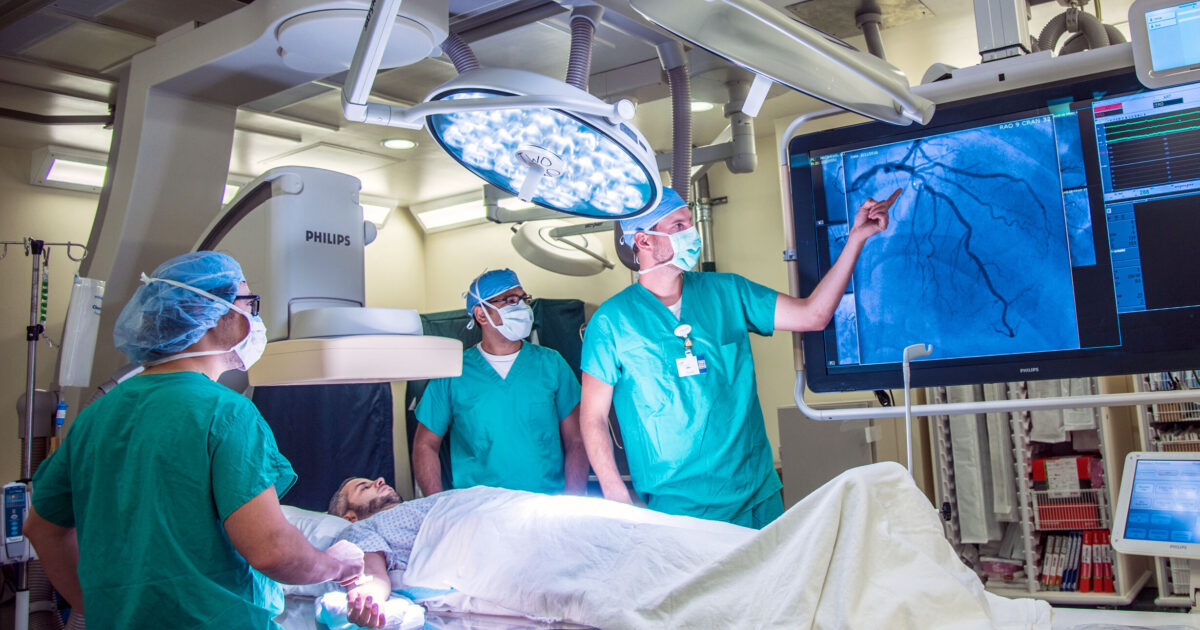Heart health after 60: Cardiology care for golden years
Heart health after 60: Cardiology care for golden years
Blog Article
Understanding the Importance of Cardiology in Modern Medical Care Services
Cardiology plays an essential role in modern health care, specifically as heart condition remains to be the leading cause of death worldwide. Developments in diagnostics and therapy have actually transformed client treatment, making it possible for earlier treatments and enhanced outcomes. Additionally, the change in the direction of preventive cardiology equips individuals to manage their health proactively. As technology continues to progress, the integration of ingenious solutions may further redefine cardiology's influence on public health, triggering a closer exam of arising fads and their effects.
The Prevalence of Heart Disease and Its Influence On Public Wellness
Although heart condition continues to be the leading cause of fatality internationally, its impact prolongs far past private patients to affect public health systems and economic situations. The high occurrence of cardiovascular disease places a considerable pressure on medical care sources, necessitating enhanced funding for treatment, rehab, and avoidance programs. Public health efforts have to attend to threat aspects such as weight problems, cigarette smoking, and less active lifestyles, which add significantly to the rising incidence of heart conditions.Moreover, the economic problem related to heart disease is tremendous, including not just straight clinical prices yet additionally indirect expenditures associated with shed productivity and premature death. Communities face obstacles in taking care of these expenses, often causing disparities in health care accessibility and outcomes. As the population ages and lifestyle-related dangers remain to intensify, the urgency for efficient cardiology interventions becomes extremely important. Subsequently, dealing with heart disease is not just an issue of individual health yet also a crucial public health and wellness top priority.
Advances in Heart Diagnostics and Imaging Techniques
Current improvements in heart diagnostics and imaging methods have actually transformed the area of cardiology, enhancing the capability to discover and monitor cardiovascular disease. Techniques such as cardiac MRI, CT angiography, and echocardiography have ended up being significantly sophisticated, offering in-depth photos of cardiac structures and features. These modalities enable for the early identification of problems like coronary artery disease, heart failure, and valvular disorders.Moreover, improvements in non-invasive diagnostics, such as wearable innovation and remote surveillance tools, have actually empowered patients and healthcare providers. These tools facilitate real-time monitoring of heart rhythms and various other necessary indications, causing prompt interventions. In addition, synthetic knowledge is being integrated into imaging analysis, improving accuracy and performance in medical diagnosis.
Technologies in Treatment Options for Heart Conditions
Current innovations in cardiology have resulted in considerable technologies in therapy options for heart conditions. These include advanced medical methods that boost step-by-step results and arising medications that provide new opportunities for therapy. As the field progresses, these technologies play a crucial role in enhancing patient treatment and outcomes.
Advanced Surgical Techniques
Technologies in medical strategies have actually transformed the landscape of cardiology, offering new hope for patients with heart disease. Minimally intrusive treatments, such as catheter-based treatments, have greatly lowered healing times and hospital remains. Methods like robotic-assisted surgery boost accuracy, enabling doctors to browse complicated anatomical structures with better accuracy. Innovations in imaging modern technology promote real-time visualization throughout procedures, enhancing outcomes. Transcatheter aortic valve replacement (TAVR) exhibits a breakthrough in dealing with aortic constriction, enabling valve substitute without open-heart surgery. Furthermore, hybrid techniques that incorporate surgical and catheter-based approaches provide customized options for various cardiac problems. These innovative surgical strategies not only boost client security yet also expand therapy alternatives, underscoring the important duty of innovation in modern cardiology practices.
Arising Medications and Treatments
As the landscape of cardiology proceeds to advance, arising therapies and medications play an essential function in enhancing treatment options for heart disease. Advancements such as unique anticoagulants and advanced lipid-lowering representatives have actually changed the monitoring of heart diseases, substantially minimizing client morbidity and mortality. In addition, the growth of genetics therapies and regenerative medicine offers appealing opportunities for treating problems previously deemed irreparable. Medical trials are constantly disclosing the efficacy of these therapies, pushing the borders of standard therapies. Moreover, the integration of electronic health technologies facilitates individualized medication, allowing for customized therapy plans based on genetic and way of living elements. Jointly, these innovations highlight the vibrant nature of cardiology, improving client results and redefining requirements of treatment in modern-day healthcare.
The Role of Preventive Cardiology in Client Treatment
Preventative cardiology plays an essential role in client care by concentrating on the recognition of danger aspects that add to heart problem. Via way of living modification strategies and early detection strategies, doctor can efficiently decrease the incidence of cardiovascular events - Cardiology. This positive technique not only enhances individual outcomes but also promotes lasting wellness
Threat Variable Recognition
While heart diseases stay a leading cause of morbidity and mortality worldwide, reliable threat aspect identification works as a cornerstone of preventive cardiology. Recognizing risk variables such as high blood pressure, hyperlipidemia, diabetes mellitus, and household background is crucial for very early treatment. Medical care experts utilize numerous screening approaches to examine these factors, enabling customized precautionary measures. In addition, understanding a person's way of life selections, such as cigarette smoking and physical inactivity, further educates risk analyses. This thorough examination enables medical professionals to develop individualized care strategies targeted at mitigating dangers. By focusing on risk aspect identification, health care systems can improve patient results and lower the overall problem of cardio diseases, eventually adding to enhanced public wellness techniques and source appropriation.
Lifestyle Adjustment Approaches
A multitude of research studies highlights the vital function of way of living adjustment approaches in reducing heart disease risk. These methods incorporate nutritional changes, see this enhanced exercise, smoking cessation, and weight management. By embracing a heart-healthy diet plan abundant in fruits, veggies, entire grains, and lean proteins, individuals can lower cholesterol levels and blood pressure. Routine physical activity enhances the heart and enhances general cardio wellness. In addition, giving up smoking cigarettes greatly decreases the risk of cardiovascular disease and enhances recuperation prices for those with present problems. Weight monitoring additionally adds to cardiovascular health and wellness by reducing other risk elements such as diabetes and hypertension. Implementing these way of living transforms not just promotes individual wellness however likewise functions as a cornerstone of preventative cardiology in person treatment.
Early Detection Techniques
Way of living adjustments significantly contribute to reducing cardio illness risks, yet they are most efficient when matched with early discovery methods. Preventive cardiology stresses the importance of identifying potential heart issues prior to they escalate right into major conditions. Strategies such as blood pressure surveillance, cholesterol screening, and progressed imaging technologies like echocardiograms play crucial duties in assessing cardio health and wellness. Biomarkers and hereditary screening also Cardiology boost the precision of very early detection, enabling tailored precautionary strategies. Routine heart risk analyses empower medical care companies to interfere proactively, potentially protecting against cardiovascular disease and strokes (Cardiology). By integrating these early discovery methods into regular treatment, clients can gain from timely way of life treatments and targeted treatments, eventually boosting outcomes and improving top quality of life
Integrating Technology Into Cardiology Practices
As improvements in innovation remain to improve various fields, the combination of cutting-edge tools and systems into cardiology methods has actually come to be important for improving individual treatment and end results. Telemedicine platforms allow cardiologists to keep track of individuals remotely, enhancing accessibility to care while reducing the problem on medical care centers. Wearable tools, such as smartwatches, enable continuous heart rate monitoring, alerting both physicians and patients to potential issues in real-time. Additionally, expert system (AI) is being made use of to evaluate huge quantities of cardiac data, assisting in early medical diagnosis and personalized therapy strategies. Advanced imaging techniques, including 3D echocardiography, enhance visualization of heart structures, leading to extra specific treatments. Electronic health records (EHRs) improve patient details monitoring, making sure that cardiologists have instant access to crucial information. With each other, these technological innovations are transforming cardiology, promoting aggressive administration and improved health end results for patients with cardio problems.
The Value of Patient Education And Learning and Involvement
Client education and learning and engagement play a crucial function in the monitoring of cardiovascular wellness. By gearing up patients with expertise about their problems, therapy choices, and way of life changes, doctor empower people to take an energetic role in their treatment. This aggressive method can cause improved adherence to prescribed drugs, dietary modifications, and workout routines, ultimately minimizing the threat of complications.Engagement also fosters a strong patient-provider partnership, encouraging open communication and count on. When individuals really feel informed and involved, they are most likely to voice worries and ask concerns, which can cause better medical results. Furthermore, academic sources, such as workshops or electronic systems, can boost understanding and promote self-management methods. In general, focusing on client education and interaction is necessary for improving cardio health and wellness, enhancing lifestyle, and minimizing medical care prices connected with heart diseases.
Future Fads in Cardiology and Their Prospective Influence

Often Asked Questions
What Lifestyle Adjustments Can Lower Cardiovascular Disease Danger?
The current question addresses way of living modifications that can considerably minimize cardiovascular disease risk. Cardiology Jupiter. Adopting a well balanced diet plan, participating in normal exercise, maintaining a healthy and balanced weight, handling tension, and avoiding cigarette can notably boost cardio wellness
Exactly How Can I Recognize Very Early Signs of Heart Issues?
Recognizing very early signs of heart troubles includes surveillance signs such as chest discomfort, shortness of breath, exhaustion, and irregular heart beat. Timely recognition of these indicators can trigger necessary clinical assessment and treatment for much better end results.
What Are the Differences In Between Cardiologists and Heart Surgeons?
The differences in between cardiologists and heart cosmetic surgeons exist in their functions; cardiologists largely take care of and detect heart problems with non-invasive approaches, while heart doctors execute surgeries to correct architectural heart problems. Each plays an essential, unique duty.

How Typically Should I Obtain My Heart Health Checked?
The regularity of heart medical examination varies based on individual danger aspects. Usually, adults ought to undertake examinations each to two years, while those with current conditions may need more frequent evaluations as advised by healthcare experts.
What Function Does Genes Play in Heart Problem Danger?
Genes greatly influences heart disease danger, with domestic patterns indicating acquired conditions. Particular genes can predispose people to high blood pressure, cholesterol issues, and various other cardio problems, highlighting the relevance of hereditary testing in examining heart wellness. Heart condition stays the leading reason of fatality globally, its impact expands much helpful hints beyond individual people to impact public health and wellness systems and economies. Public health initiatives must deal with threat factors such as obesity, cigarette smoking, and inactive lifestyles, which contribute greatly to the climbing occurrence of heart conditions.Moreover, the financial worry associated with heart illness is immense, including not only straight medical prices however likewise indirect expenditures related to shed productivity and premature death. Preventative cardiology plays a vital role in patient treatment by concentrating on the recognition of danger factors that add to heart illness. Fabricated intelligence (AI) and maker learning are enhancing diagnostics and client tracking, making it possible for very early discovery of heart conditions. The distinctions in between cardiologists and heart surgeons lie in their roles; cardiologists mainly identify and handle heart problems with non-invasive techniques, while cardiac specialists do surgical procedures to fix structural heart issues.
Report this page